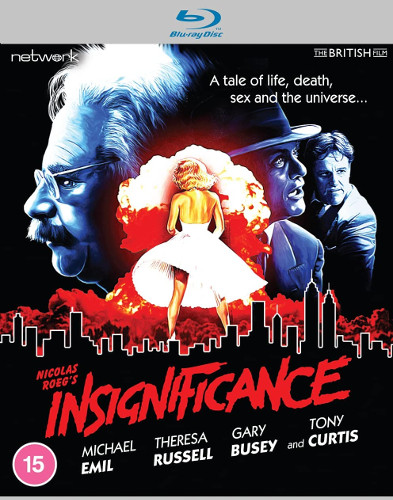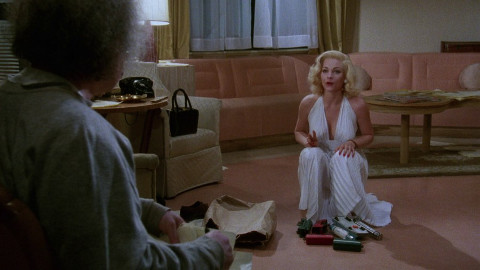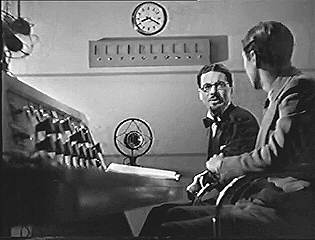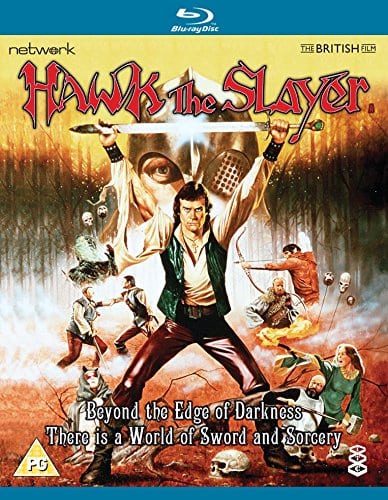Insignificance (1985)
Directed by: Nicolas Roeg
Written by: Terry Johnson
Starring: Gary Busey, Michael Emil, Theresa Russell, Tony Curtis
UK
AVAILABLE ON BLU-RAY: 12st JUNE, from NETWORK DISTRIBUTING
RUNNING TIME: 109 mins
REVIEWED BY: Dr Lenera

1954. The Ballplayer, The Professor, The Actress and The Senator – who might as well be named Joe DiMaggio, Albert Einstein, Marilyn Monroe and Senator Joseph MacCarthy – all cross paths in a hotel during the course of one single night and the following morning. DiMaggio is insecure about his celebrity, self-obsessed, and prone to violence. Einstein seems unhappy about something really important and hides behind words, yet might just fancy the simplicity of a sexual liaison with Monroe. Monroe, who’s married to DiMaggio even though neither of them seem to really know each other, is sick of being seen as a bimbo and craves intellectual credence. And MacCarthy is at the height of his witch-hunting powers and wants Einstein to name names….

“Is it too late or too early”? asks Monroe. “It’s relative” replies Einstein who provides several wise yet easily understandable nuggets throughout, another favourite being “you can never understand only by agreeing”. When Monroe died at the young age of 36, her death was ruled a suicide, yet many key witnesses who saw Monroe the night of her death provided contradicting stories, her business manager set about burning her papers and changed the lock on Monroe’s filing cabinet, and her address book disappeared, which only added to the mystique of the iconic star whose appeal I’ve never been able to work out, yet it drew many to her and endures. As well as being married to DiMaggio and Arthur Miller, she publicly hung out with the likes of Norman Mailer and Laurence Olivier, while many have claimed that she had affairs with John and Robert F. Kennedy among others. Therefore it’s very possible that her address book may well have included names such as Albert Einstein and Joseph McCarthy. At the very least, she may very well have crossed paths with them. When I first saw Insignificance I’d been a fan of director Nicolas Roeg for some time, and I still think that his five-film run from Performance to Bad Timing is one of the most extraordinary runs in cinema. His later work still threw up some interesting stuff, but the slightly twee and enormously verbose Insignificance came across as pointless and dull at the time. Nonetheless, having already reviewed Roeg’s first six films over the years for Horror Cult Films, I was interested in revisiting his 1985 offering – and now found it to be really rather good. Roeg’s directorial fireworks can’t disguise that it’s a filmed play, but filmed plays can be good too, which is not something I obviously appreciated when I was much younger.
The play was written by Terry Johnson and performed at the Royal Court Theatre in London in 1982, with Judy Davis as The Actress. Johnson was inspired to write it by learning that an autographed photograph of Einstein was found amongst Monroe’s possessions upon her death, and became fascinated by the idea of them meeting. Roeg saw the play and was immediately fascinated by it, though for him it was the Monroe/Dimaggio marriage that most intrigued him. He felt that “it might be a tool to use, an incident came up in my own life and I thought, ‘Good God, nobody knows a damn thing about anyone.’ Star Theresa Russell says that it wasn’t Roeg who initiated the project. “I don’t know if Nic will even remember that, because he kind of rearranges history sometimes like his movies”. According to her, producer Alexander Stewart approached her first, though she didn’t want to do it while Johnson wanted Davis to again play Monroe. When Roeg became interested, both she and Johnson changed their minds. Roeg asked Johnson to work on the screenplay, which initially meant just shortening the play by around half an hour, but then Roeg began making suggestions about opening things out, flashbacks which would deepen the characters and even a flashforward. All of the interiors were shot at Lee Studios in Wembley Park, England, with second-unit exteriors shot in New York City. It was entered into competition at the Cannes Film Festival in 1985 where it was nominated for the prestigious Palme d’Or Award but won instead the Technical Grand Prize. As usual with Roeg, it was a commercial failure.
A swinging watch is the first thing that we see, immediately clueing us in to the fact that this will be another film from Roeg where time is a major factor. Indeed he will frequently flash back to past times that have shaped and generally tormented our four main characters, using his editing mastery to present unexpected connections between time, place and circumstance, with the repeated visual motif of this watch being employed to mark time’s passing, as well as perhaps to suggest that each moment could possibly be co-existing. The script even has Monroe mention the principle of the neutron bomb, which hadn’t been created yet but which makes a lot of sense in context. She’s really the character who most draws the others, so it’s right that we should begin with the setting up of her famous scene from The Seven Year Itch where she stands on a grate while the rush of wind caused by a huge fan to imitate the subway going by below blows her white skirt up around her waist. We’re also introduced to MacCarthy drinking in a bar and talking some boozy nonsense to another guy about the fact that they’re basically drinking Napoleon, and Einstein sitting on a hotel room bed working out some equations. A flash cut to a dead body is inserted into one of the shots of Einstein, beginning a mystery about him that will only be revealed near the end, but the intercutting favours Monroe for some time, which makes sense seeing as the objectifying of stars, especially female like Monroe, is one of the major themes. When Monroe takes a taxi ride she bluntly sums up her deal. She knows her lot is to basically be perved over by men, but what we also notice is how controlled she is. The car is supposed to take her to her husband’s house but she wants to stop off at a shop; however, it takes some persuasion to be allowed to do this, persuasion which ironically involves her using her sexy image she doesn’t like just a little.

From here on things take the form of lengthy discussions as our four characters will meet, usually as pairs, though sometimes as threes. It’s no wonder that I was bored as a teenager, but as a considerably older adult I was able to enjoy the dialogue, the performances, what the film seemed to be saying about things such as image, stardom, how we often don’t communicate properly our needs and fears, and, the differences between who people really are, as opposed to who we may think they are or are indeed be asked to think how they are. The first major scene is between Einstein and MacCarthy, who comes into Einstein’s hotel room to alternately coax and threaten him into appearing before a commitee to investigate his activities and answer the famous question, “Are you now or have you ever been…?” Einstein refuses as he wants to attend a different meeting that’s far more important to him, and easily shows up MacCarthy’s ignorance, stupidity and even racism. MacCarthy leaves, saying he’ll be back to get him at 8 a.m. the following morning. The scene is quietly menacing, something enhanced by a detail we notice almost immediately; MacCarthy is really, really sweating. Now we know that Einstein was never actually investigated by the House of Un-American Activities, but he may well had the atrocious situation continued for longer than it actually did. Then Monroe visits Einstein wanting to learn from him as well as show that, actually, she’s not the dumb blonde everyone sees her as. She’s pleased when he doesn’t even know who she is, and, while he doesn’t seem interested in sex and can’t understand why a woman would want him, might he succumb to the advances of a woman who’s never been turned down? Of course her spouse DiMaggio is also around, and we know that MacCarthy will eventually return.
The story doesn’t really go to many interesting places in terms of events, preferring simple farce situations to make its points, the idea of people not being much like they seem reaching a peak when Monroe is mistaken for a prostitute imitating Monroe. The flashbacks reveal troubled backgrounds to all four characters who obsess over wanting piece of mind, something that they cannot have. The ones of MacCarthy, thrown in near the end, don’t seem to have a point to them unless I missed something. However, the character who’s in some ways the simplest of the four, the one who seems to have the least to hide, is revealed to be impotent, which doesn’t excuse how nasty he is but does allow us to have some measure of pity for him; this probably really torments him, as well it might. Indeed “torment” could be the main word here. Einstein clearly isn’t too comfortable with human contact and loses himself in numbers, letters and equations, but when we find out why he’s this way we entirely understand, as well as forgive the film for providing a seemingly out of place though technically well achieved despite the moderate budget, apocalyptic climax. We also realise what the oddest of the film’s flashbacks mean. The desperately child-wanting Monroe is shown to have been exploited all her life sexually, while the seemingly arrogant DiMaggio is actually uncomfortable with his fame and reveals a sensitive side even if he’s not too bright. The scenes between Monroe and DiMaggio show a marriage by two people, presumably mainly brought together mainly by lust, who don’t actually know each other at all. He even says that Monroe “needs people touching her all the time” which doesn’t seem to be the case at all.
Roeg gives us some of his best transitions, such as blowing blinds becoming an almost abstract reflection of a boat on a lake, while an often seen splintered nude calendar shot of Monroe not only reflects the way her psyche has been divided but also serves as a metaphor for Roeg’s often non-linear filmmaking. However, he focuses on his actors more strongly than ever before. While everyone is good including Will Sampson as a Cherokee lift attendant who thinks that Einstein must also be Cherokee because of his wisdom, and Gary Busey’s intelligent performance makes one wonder if he was should have been given more complex parts than he normally got, it’s often Russell’s show. She’s one of those actresses who seemed to be on the verge of stardom throughout the ’80s, but who never quite made it. Here, instead of falling into the trap of mimicking Monroe and falling short like many do, she builds her character up from the bottom then adds elements of Monroe. Some of that heady sexual power that she displayed in Bad Timing is also present, though it’s more comedic here. The pitfalls of stardom affect all of the characters in very differing degrees, but it’s Monroe who we’ll most remember, probably because we identify that with the real person anyway. We’re also reminded that we shouldn’t assume that people are like their image in this unusually charming and whimsical film from Roeg. A nicely diverse music soundtrack mixing pop songs, jazz from Stanley Myers, beaty synth stuff from Hans Zimmer and a neat arrangement of Mozart’s Jupiter Symphony adds extra enjoyment. Now I did wonder for a while if the cosmic references were really necessary, working only as a very obvious device to show how, well, insignificant their troubles and interactions are. But then we realise their importance when we’re shown how quantum science has led to something that could end our existence. Likewise just before this the film has its cleverest person do something that seems rather stupid – yet to him it was no doubt the best thing to do. It’s all relative.
Rating: 









It’s probable that Network are using the same restoration that is on Criterion’s Region ‘A’ release, as there’s no mention of it being totally new. the image depth, clarity, grain management and color reproduction are highly impressive. It also looks totally clean; I didn’t spot a single even minor blemish. The picture is quite soft some of the time, but it seems that the film was intended to look like this, especially the hazy flashbacks, though virtually all of the many close-ups of the characters are immensely detailed. Very good indeed.
SPECIAL FEATURES
‘That’s Insignificance’ – 1984 making-of featurette [14 mins]
Ported over from the Criterion, this intersperses clips from the shooting of several scenes with interview bites from the stars. Emil says that, even if he wasn’t a sexual person, Einstein was one of ideas so he would have certainly been tempted to go to bed with Monroe as an idea. Curtis says how McCarthy was less the villain than the ones telling him what to do. Busey says how to succeed in show business you need to learn how to make your own salad, fall in slow motion and cry. Russell is surprisingly not to the fore at all, and we don’t hear from Roeg either. Still, this is a nice piece.
‘Gone Roeg’ – interviews with Mary Holdsworth [continuity], Diane Johnson [hairdressing] and Simon Bodanquat [production manager] [47 mins]
The Criterion had interviews with Roeg and producer Jeremy Thomas; Network were obviously unable to source those so we have these two featurettes instead. The first one has Mary Holdsworth [continuity], Diane Johnson [hairdressing] and Simon Bodanquat [production manager] discuss their experiences on the film and, while obviously one hopes for the likes of Russell instead, the three do provide some interesting recollections. Holdsworth has her copy of the script to hand and shows us some of her notes, Johnon tells of how she had to take over the role of set dresser but got into trouble when she didn’t have a ticket [in those days you had to have a ticket to work on a film], and Bodanquat tells us all the London locations. There aren’t any hugely dramatic stories, but then it seems like it was a very cordial set.
‘Imitation of a Scene: interview with Ray Charleson [Bud] [5 mins]
Charleson describes how he got his tiny role as an electrician who we see at the beginning of the film [Roeg didn’t think he was suitable until told that he’d seen him in a play the previous evening and hadn’t recognised him] and what his few hours on set were like.
Alternative audio track featuring Stanley Myers’ isolated musical score
Theatrical trailer
Image gallery
Limited edition booklet written by Neil Sinyard
Just falling short of prime Roeg but still fascinating and with a slightly lighter touch than usual, ‘Insignifance’ gets a pretty good Blu-ray release in the UK from Network. Highly Recommended.





Be the first to comment